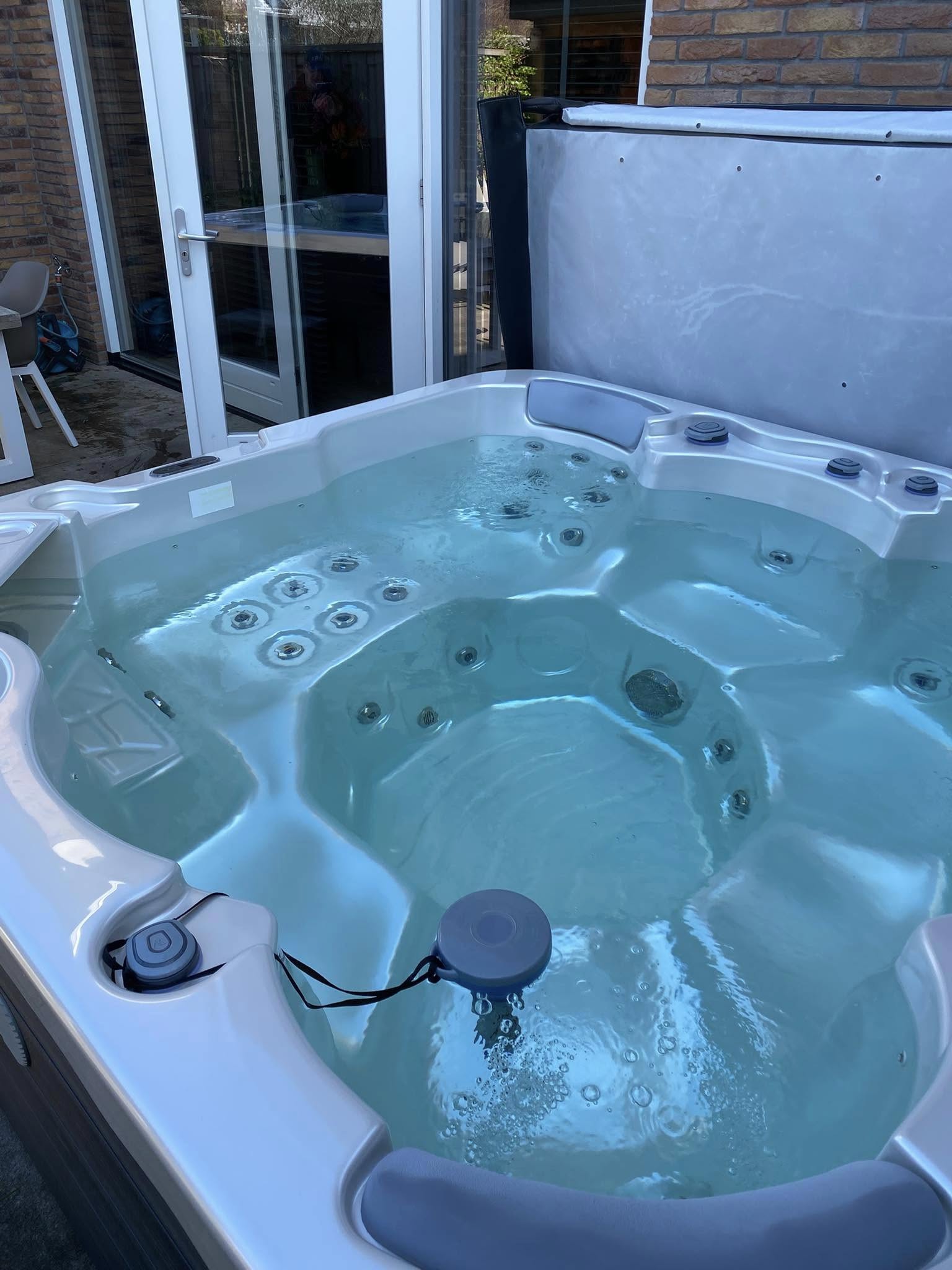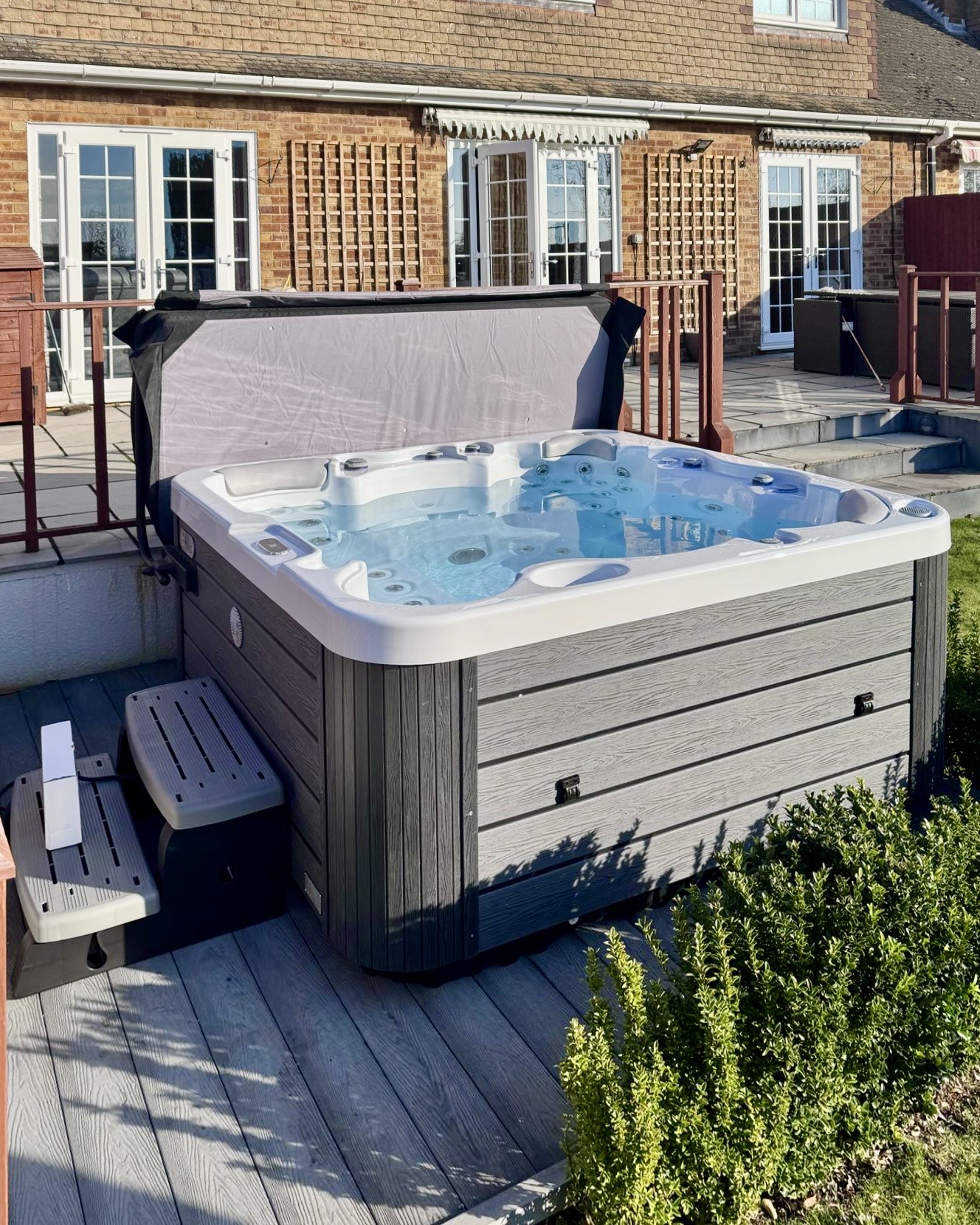There’s nothing quite like sinking into your hot tub at the end of a long, hard day. However, if you’re greeted by a strong chemical smell or leave the water with itchy, red skin, then you may have an issue with your chlorine levels. Chlorine is essential to keep your spa water clean and hygienic, but using too much can be harmful. This guide will explore how to reduce chlorine in a hot tub safely, how to recognise signs of high chlorine in a hot tub, and how to ensure you have balanced water for the ultimate spa experience.
Why Chlorine Is Important in Hot Tubs
Chlorine is the most common sanitiser used in hot tubs. It works quickly to kill harmful bacteria, viruses and algae that can otherwise thrive in warm water. Chlorine is the most popular sanitiser due to its effectiveness and affordability, although bromine, mineral-based systems, ozone or UV technology can also be used.
Sanitising is important to keep your hot tub safe, but when using chlorine, it’s important to get the spa water balance right. The ideal chlorine range for hot tubs is between 1 and 3 parts per million (ppm). Staying within this range means your water is clean and hygienic without the overpowering chemical smell, which can cause skin irritation and equipment damage.

Signs Your Chlorine Level Is Too High
One of the first signs of too much chlorine in a hot tub is a strong chemical smell when you lift the hot tub lid. Many misinterpret this as a sign of being clean, when in fact it’s the opposite. It usually signals that chlorine is reacting with organic matter and forming chloramines, which are far less effective at sanitising.
Another common sign is skin irritation. If you or your guests experience red eyes, dry skin or a stinging sensation after using the spa, this indicates high chlorine levels. Sometimes the water can become cloudy or foamy, particularly if chlorine levels remain high over time. If you’re unsure, test your water using test strips or a digital testing kit. If chlorine levels are consistently above 3 ppm, then it’s important to act. Let’s explore how to decrease chlorine in hot tub
How to Reduce Chlorine in a Hot Tub
Immediate Solution
The quickest way to lower chlorine in a hot tub is to simply uncover it and allow the water to aerate. Exposure to oxygen and fresh air helps chlorine dissipate naturally. Turning on the jets while the cover is off can speed up this process, as increased water movement can encourage chlorine to evaporate.
If the levels are particularly high, then draining some of the water and topping up with fresh water can be effective. Simply diluting the water lowers the concentration of chlorine and can also help reset your water balance. During this process, it’s important not to add any chlorine to the water and monitor levels daily until they stabilise to ensure safe chlorine levels in the hot tub.
Natural Decline
A longer but effective way is natural decline. Sunlight, particularly UV rays, breaks down chlorine over time. So, leaving your spa uncovered on a bright day can be an easy, no-cost way to reduce chlorine gradually. Keep the jets running to maintain circulation but avoid adding any more chemicals during this period.
Using Chemical Neutralisers
If you need a quicker fix, chlorine neutralisers are available. These products are usually based on sodium thiosulfate and are designed to bind with chlorine and render it inactive. They work quickly and are ideal if you want to use your spa soon but need to bring chlorine levels down fast. By using chemical neutralisers, you will quickly reduce chlorine smell. Always follow the product’s instructions carefully when dosing your hot tub and retest the water after treatment to ensure it’s safe to enter.
Preventing Future Chlorine Imbalances
Proper Chlorine Dosing
The best way to manage chlorine levels is through regular hot tub water maintenance. Testing your water two to three times a week is a good habit, especially if the hot tub is used frequently. Make sure you follow your chemical manufacturer’s guidance when adding chlorine and avoid guessing the dosage. Overdosing is one of the most common causes of chlorine spikes.
Balancing Water Chemistry
Maintaining the right pH level also makes a significant difference. Chlorine is most effective when the pH sits between 7.2 and 7.6. If pH is too high or too low, then chlorine becomes unstable, and you may find yourself using more than necessary. Alkalinity should also be checked, ideally falling within the 80 to 120 ppm range. Balanced water chemistry not only helps maintain safe chlorine levels but also improves the overall performance and lifespan of your spa components

What Happens if Chlorine Levels Stay Too High?
Persistent high chlorine levels can cause many issues. Health-wise, users may experience skin and eye irritation, headaches or even respiratory discomfort. This is particularly concerning for children or anyone with sensitive skin.
You may also cause damage to your hot tub. High chlorine levels can damage internal components like seals, jets and heaters. Over time, it can lead to discolouration, brittle plastic parts and premature wear. For those with premium hot tubs, excessive chlorine may also void warranties, as many manufacturers specify acceptable chemical ranges for coverage to remain valid. It’s crucial as a hot tub owner you understand how to lower chlorine levels in hot tubs.
Are There Alternatives to Chlorine in Hot Tubs?
If you’re looking to reduce your reliance on chlorine, there are several chlorine alternatives for hot tubs. Bromine is one of the most popular options and is particularly suited to hot tubs because it remains stable at high temperatures and produces less of a chemical smell. It is also gentler on the skin, which is perhaps an attractive option to those with sensitivities.
Mineral-based systems are another option. These use natural elements like silver and copper to inhibit bacterial growth, meaning you can use significantly less chlorine or bromine overall. Ozone and UV systems are also gaining popularity, especially in high-end spas. These systems sanitise the water by breaking down contaminants at a molecular level, reducing the need for any additional chemicals.
Each system comes with its own benefits and considerations, and choosing the right one depends on your spa setup, your budget and personal preferences. Many of the latest models in our Wellis Premium Hot Tub collection feature advanced water care systems designed to minimise chemical use while delivering superior water quality.
How to Reduce Chlorine in Hot Tub the Right Way
Managing hot tub chemicals is key to a safe, soothing and enjoyable spa experience. If you’re dealing with too much chlorine, it’s important to understand how to decrease chlorine in a hot tub. A good start is to act quickly by uncovering the water and diluting with fresh water or using a neutraliser. Routine hot tub water maintenance and regular testing are key; stay on top of your spa water balance and consider switching to a more advanced or alternative sanitising method if high chlorine levels are a recurring issue. If you find high chlorine levels are a recurring issue, perhaps consider the chlorine alternatives available.
At Wellis UK, we’re here to support every part of your hot tub journey. From spa chemicals to premium hot tub models, our goal is to help you maintain a perfect water experience, every time.